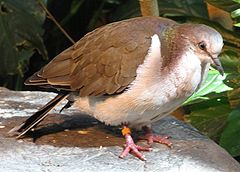Leptotila
| Leptotila[1] | |||
| Swainson, 1837[2] | |||
 Przedstawiciel rodzaju – gołębik duży (L. jamaicensis) | |||
| Systematyka | |||
| Domena | eukarionty | ||
|---|---|---|---|
| Królestwo | zwierzęta | ||
| Typ | strunowce | ||
| Podtyp | kręgowce | ||
| Gromada | ptaki | ||
| Podgromada | Neornithes | ||
| Infragromada | ptaki neognatyczne | ||
| Rząd | |||
| Rodzina | |||
| Podrodzina | gołębie | ||
| Rodzaj | Leptotila | ||
| Typ nomenklatoryczny | |||
| Peristera rufaxilla Selby, 1835 (nie Richard & Bernard, 1792) (= Columba jamaicensis Linnaeus, 1766) | |||
| Synonimy | |||
| | |||
| Gatunki | |||
| |||
| |||
| |||
Leptotila – rodzaj ptaków z podrodziny gołębi (Columbinae) w rodzinie gołębiowatych (Columbidae).
Zasięg występowania
Rodzaj obejmuje gatunki występujące w Ameryce[8].
Morfologia
Długość ciała 22,5–33 cm; masa ciała 96–205 g[9].
Systematyka
Etymologia
- Leptotila (Leptoptila, Leptophila): gr. λεπτος leptos „smukły”; πτιλον ptilon „pióro”[10].
- Homoptila: gr. ὁμοιος homoios „jak, podobny”; πτιλον ptilon „pióro”[11]. Gatunek typowy: Homoptila decipiens Salvadori, 1871 (= Leptotila verreauxi Bonaparte, 1855).
- Engyptila: gr. εγγυς engus „prawie, jak”; πτιλον ptilon „pióro”[12]. Nowa nazwa dla Leptotila Swainson, 1837.
- Aechmoptila: gr. αιχμη aikhmē „włócznia”; πτιλον ptilon „pióro”[13]. Gatunek typowy: Columba jamaicensis Linnaeus, 1766.
Podział systematyczny
Do rodzaju należą następujące gatunki[14]:
- Leptotila verreauxi – gołębik białosterny
- Leptotila jamaicensis – gołębik duży
- Leptotila cassini – gołębik szaropierśny
- Leptotila conoveri – gołębik kolumbijski
- Leptotila ochraceiventris – gołębik ochrowy
- Leptotila plumbeiceps – gołębik siwogłowy
- Leptotila rufaxilla – gołębik szaroczelny
- Leptotila wellsi – gołębik grenadyjski
- Leptotila pallida – gołębik blady
- Leptotila megalura – gołębik białolicy
Przypisy
- ↑ Leptotila, [w:] Integrated Taxonomic Information System (ang.).
- ↑ W. Swainson: On the natural history and classification of birds. Cz. 2. London: John Taylor, 1837, s. 349. (ang.).
- ↑ Ch.L. Bonaparte. Description of new or interesting Birds from South America and Mexico. „Proceedings of the Zoological Society of London”. 5, s. 113, 1837. (ang.).
- ↑ H. Bryant. A List of the Birds of St. Domingo, with Descriptions of some New Species or Varieties. „Proceedings of the Boston Society of Natural History”. 11, s. 96, 1868. (ang.).
- ↑ T. Salvadori. Nuove specie di uccelli dei generi Criniger, Picus ed Homoptila Nov. Gen.. „Atti della Reale Accademia delle Scienze di Torino”. 6, s. 131, 1871. (wł.).
- ↑ C.J. Sundevall: Methodi naturalis avium disponendarum tentamen: försök till fogelklassens naturenliga uppställnung. Stockholm: Samson & Wallin, 1872, s. 156. (łac.).
- ↑ E. Coues. Notes on the Ornithology of the Lower Eio Gracde of Texas, from observations made during the season of 1877. „Bulletin of the United States Geological and Geographical Survey of the Territories”. 4 (1), s. 48, 1878. (ang.).
- ↑ F. Gill, D. Donsker & P. Rasmussen (red.): Pigeons. IOC World Bird List (v10.2). [dostęp 2020-08-08]. (ang.).
- ↑ L.F. Baptista, P.W. Trail & H.M. Horblit: Family Columbidae (Pigeons and Doves). W: J. del Hoyo, A. Elliott & J. Sargatal: Handbook of the Birds of the World. Cz. 4: Sandgrouse to Cuckoos. Barcelona: Lynx Edicions, 1997, s. 168–171. ISBN 84-87334-22-9. (ang.).
- ↑ Jobling 2021 ↓, s. Leptotila.
- ↑ Jobling 2021 ↓, s. Homoptila.
- ↑ Jobling 2021 ↓, s. Engyptila.
- ↑ Jobling 2021 ↓, s. Aechmoptila.
- ↑ Systematyka i nazwy polskie za: P. Mielczarek & M. Kuziemko: Podrodzina: Columbinae Leach, 1820 - gołębie (wersja: 2021-04-04). [w:] Kompletna lista ptaków świata [on-line]. Instytut Nauk o Środowisku Uniwersytetu Jagiellońskiego. [dostęp 2021-04-17].
Bibliografia
- James A. Jobling: The Key to Scientific Names. [w:] Birds of the World [on-line]. Cornell Laboratory of Ornithology, Ithaca, NY, USA, 2021. (ang.).











